The Best Acoustic Guitar Preamp Pedal Complete Buyers Guide
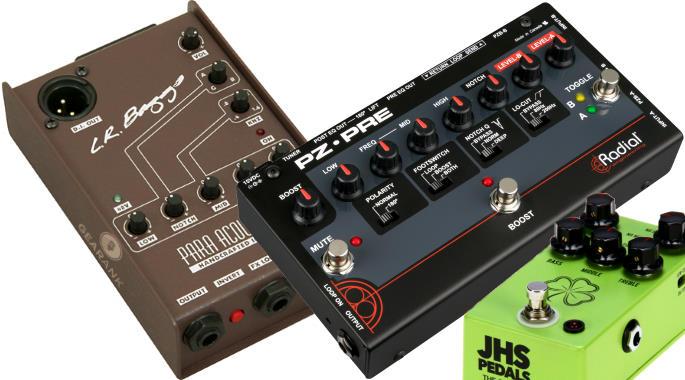
Best Acoustic Guitar Preamp Pedals
These are the acoustic preamps that have received the highest ratings - see How Gearank Works for further information about Gearank Ratings.
LR Baggs Para DI
Cons
- Small control knobs
- No footswitch control
Pros
- Versatile EQ with tunable notches
- Can target and tweak problematic frequencies
- Transparent sounding preamp
- Intuitive control layout
LR Baggs is known for quality acoustic gear, and the Para DI is a great showcase of what the brand is all about. What sets the LR Baggs Para DI apart is its versatile 5 band EQ with tunable notch filter and midrange bands. These extra controls allow for extensive tone shaping that you won't usually get from a preamp.
The five band EQ knobs all have big ranges. This allows for subtle adjustments to fix venue related sound issues. While bigger changes can substantially shape the overall sound. The tune knobs let you zero in on problematic frequencies and boost or lower them down as needed. These tone shaping controls can let you tweak for a fuller sound in case you're playing solo or with a small group. Those who play with bands can utilize the Para DI to go for a more mid-focused cutting tone.
It lets you do all this in a very intuitive manner without having to dive into complex menus and buttons. Note that absolute beginners may not immediately understand how the EQ and notch filter knobs work. But it doesn't take much to figure it out, especially if they get help from experienced musicians.

The LR Baggs Para Acoustic DI can run on a 9V battery
At the core of these nifty tone shaping options are is a transparent sounding preamp. With it, you retain much of the original voicing of your guitar when you tweak the EQ controls. This transparency caused some first-time users to encounter feedback issues. Thankfully, you can reduce feedback easily by adjusting the notch filter and phase inversion.
Note that while it works great with acoustic-electric guitars, the Para DI is also quite popular among violinists. It is also used by musicians who play other pickup-equipped acoustic instruments. Other practical features include feedback control via phase inversion. It has the option to power the unit via a 9V battery or via phantom power.
Its compact form factor and straightforward design make the PARA DI preamp viable for floor or desk setups. Speaking of compact, the knobs are quite small, which makes real-time tweaking during performances a bit of a challenge. So it is recommended to get the tweaking done before performing, so you won't have to reach for the small knobs as you perform. Another limitation of the Para DI is the lack of footswitch control.
If you're a multi-instrumentalist that plays various acoustic instruments this is for you. But you have to be willing to put some time in fine-tuning your EQ and notch filters.
Specifications
- Profile: Single Pedal (No Footswitch)
- Controls: Volume, Low, Notch, Mid, Pres, Treble, Notch Variation, Mid Variation
- Input: 1 x 1/4"
- Output: 1 x 1/4", 1 x XLR (DI Out)
- Powered By:48V Phantom Power, 9V Battery
- Dimensions: 1.9" x 3.6" x 5.6"
- Weight: 0.9 lbs.
| Website | Source | *Rating Value |
| MusicPlayers | Derek Davodowich | 93/100 |
| Rex and the Bass | Rex | 94/100 |
JHS Clover Electric Acoustic Preamp Pedal
Cons
- Not a dedicated acoustic preamp
- No anti-feedback feature
Pros
- Transparent full sounding preamp
- Can be used as boost effect
- Can work with acoustic and electric guitars
- Versatile EQ modes and controls
The JHS Clover is an all-around preamp / boost pedal that can work with acoustic, electric, and even bass guitars. It behaves similarly to the FET preamp of the 80's Boss FA-1, as used by U2's the Edge. Only this one offers more tone shaping and output options.
At lower volume levels, the preamp is very transparent. It has a subtle low-end bump that makes the resulting sound fuller, great for always-on basic preamp use. Raising the volume higher adds grit to the tone, allowing the pedal to behave like a boost pedal. Understandably, this boost functionality appeals to those who play electric guitars. But with some EQ tweaks, the JHS Clover's boost can also work great for acoustic - as long as the volume knob is not pushed too hard.
JHS equipped this pedal with a rotary switch that lets you choose between three EQ modes: Full EQ, No Mid, and No EQ. These EQ modes affect the 3 band EQ knobs that come with the preamp. The No Mid setting is closer to the original FA-1 pedal as it disables the MID EQ control. The other modes are self-explanatory, Full EQ engages the three band EQ knobs, while No EQ disables all three for preamp only functionality.

JHS Clover Low-cut switch
The No EQ and No Mid options allow for straightforward preamp use, which is easier to integrate into different types of setups. The Full EQ mode turns the Clover into a versatile preamp plus EQ unit. Further tone shaping is possible with its side-mounted switch for engaging Low-cut functionality.
This pedal gives you two output options, a regular 1/4" and a balanced XLR output which you can use for plugging directly into a mixing desk.
The JHS Clover is a good versatile preamp to have if you play both electric and acoustic guitars. While it may lack some features, it can get the job done.
Specifications
- Profile: Single Pedal
- Controls: Volume, Bass, Middle, Treble, EQ Mode, Ground/Lift
- Input: 1 x 1/4"
- Output: 1 x 1/4", 1 x XLR (Balanced Out)
- Powered By: 9V Power Supply (Sold Separately)
- Dimensions: 1.6" x 2.6" x 4.8"
- Weight: 0.59 lbs.
| Website | Source | *Rating Value |
| The Gear Page | DecoWaves | 94/100 |
| YouTube | The Gear Cage | 95/100 |
Radial Tonebone PZ-Pre
Cons
- Bulky and heavy
- Not for those who want a basic preamp
Pros
- Stage ready input/output options
- Versatile EQ controls
- 2-Channel Preamp with footswitch
- Built-in boost with footswitch
Radial continues to do well in the preamp market thanks to their high quality pro audio products. The Tonebone PZ-Pre is their best rated preamp for acoustic instruments. Packed with features and functions that are usually limited to studio quality rack preamps.
It has expanded tone shaping options, and versatile input/output, while retaining Radial's acclaimed high-fidelity preamp and DI. And this ability to morph the sound of your acoustic guitar however you want to is really what the PZ-Pre is all about. The Low EQ knob is paired with multiple Low-cut modes that give you precision control over the lower frequencies. Mid controls include a freq knob. If that's not enough, the unit has a notch knob with multiple Notch Q modes.
Another nifty feature of the PZ-Pre is the included boost footswitch and boost level knob. This lets you boost the signal for emphasizing certain parts, and do so hands-free. Thankfully, it does not color the sound as much as regular boost effects, retaining the sonic flavor of your instrument.

Piezo buffer switch for passive pickups
Speaking of coloration, the preamp has that high-definition sound quality that you'd expect from Radial. So even if you set everything mid-way, you're always getting a transparent guitar sound. And it doesn't stop at just one preamp, the PZ-Pre has two preamps with dedicated footswitch control. It also has pre and post EQ, allowing for precise control over your sound for both the FOH and your monitor. There's also a "piezo buffer" switch on the side for better compatibility with passive pickups.
And I'm not the only one who is impressed, it has a long list of satisfied owners, including big-name artist endorsers like James Taylor, Jerry Douglas, Keb Mo, and many more.
Given all these features and controls, the Tonebone PZ-Pre is quite bulky and heavy. So if you're looking for something simple and compact, you may want to consider smaller units like the Fishman Aura Spectrum, which also has Di Box funcitonality.
Note that this is the newer facelifted version of the PZ-Pre, which carries over the Loop On feature that was introduced a while back.
If you're looking for a powerful transparent Acoustic DI Box solution for your acoustic guitar or other acoustic instruments, then the Radial Tonebone PZ-Pre is definitely worth checking out.
Specifications
- Profile: Multi-Switch Pedal
- Controls: Boost, Low, Freq, Mid, High, Notch, Level-B, Level-A, Polarity, Footswitch, Notch Q, Low Cut, 3 x Footswitches (Mute, Boost, Toggle)
- Input: 2 x 1/4", 1 x 1/4" (Return)
- Output: 1 x 1/4" (Amp), 1 x 1/4" (Send), 2 x XLR (Pre/Post EQ), 1/4" Tuner
- Powered By: 15V Power Supply (Included)
- Dimensions: 2" x 8" x 4.25"
- Weight: 2.7 lbs.
| Website | Source | *Rating Value |
| Audiofanzine | iamqman | 80/100 |
| Sound On Sound | James Dunkley | 98/100 |
Grace Design ALiX
Cons
- Needs quite the investment
- Not a basic plug-and-play preamp
Pros
- Studio quality quiet signal path
- Versatile EQ controls
- Transparent and musical sounding preamp
- Built-in Boost
The Grace Design ALiX is a premium instrument preamp with expanded EQ controls and studio quality quiet signal path.
Its focal feature is its versatile and natural sounding EQ section, which lets you adjust highs, lows, and mids more precisely via pass filters, notch and Parametric EQ controls. This way you can zero in on frequencies that need to be cut or boosted, and do so while retaining a relatively intuitive layout. I say relatively because the rabbit hole of controls can go even deeper with DIP switches on the side. Still, the control layout is well thought out and should be easy to get the hang of for experienced guitar players.
All these EQ controls would mean nothing if the core sound was bland, thankfully this pedal has a very transparent and musical sounding preamp that's perfect for acoustic guitars. With just a few tweaks, you can get your guitar to sound natural, and you get even better results as you get used to adjusting its many EQ controls. Another important feature of the ALix is its built-in boost function, with dedicated boost knob and footswitch. And the type of boost it produces is tuned specifically for acoustic instruments.
For better compatibility with different pickup types, it also comes with 3 input impedance modes. There are also controls for Gain and Amp output, which further expands the versatility of the pedal. Other features include having a phase reverse switch, DI output, built in tuner out, and effects loop insert.
While it can be easy to get a good sound, it will take quite a while to get a good handle on everything that this pedal can do. This is definitely not for those who prefer simple preamps.
Everything about the ALiX feels premium and roadworthy. If you have the money to spend and want nothing less than a high quality single channel preamp for your acoustic guitar, then check out the Grace Design ALiX.
Specifications
- Profile: Double Switch Pedal
- Controls: Gain, Notch, Low, Mid, High, Mid Frequency, Boost, Mid Q, Amp, Ground/Lift, Amp Out Level, Input Frequency, 2 x Footswitches: Boost, Tuner/Mute
- Input: 1 x 1/4"
- Output: 1 x 1/4" (Amp Out), 1 x XLR (DI Out)
- Powered By: Standard IEC AC cable, Additional 9V 500mA
- Dimensions: 3" x 6.2" x 5.5"
- Weight: 2.2 lbs.
| Website | Source | *Rating Value |
| Acoustic Guitar | Doug Young | 90/100 |
| YouTube | Shawn Tubbs | 95/100 |
Things to Consider when Buying an Acoustic Guitar Preamp
What is an Acoustic Guitar Preamp and How Does it Work?
Acoustic guitar preamps are specifically tuned for acoustic-electric guitars. They work like mini-amplifiers, in that they receive the audio signal from your pickup system and amplify them to your intended levels.
On top of their basic functions, Preamps can have other features like EQ, notch filter, body resonance and more. Often times, these extra features are what makes them worth getting.
Do I Need a Special Preamp for Acoustic Guitar?
You can get good guitar tone with your acoustic-electric guitar's built-in electronics plugged straight to a PA system or an acoustic amp. But you if you want more control over your acoustic guitar sound, then you'll definitely benefit from an acoustic preamp.
Related Guides
If you're a set and forget type of player, you'll appreciate small preamps with limited features. They are easy to use and give consistently good results.
The more complex preamps are reserved for those who want more control over their acoustic sound. They come with expanded tone shaping controls, and multiple switches for real time adjustments. The downside is that you'll need to be knowledgeable about the different parameters to make the most out of their features.
So, the short answer to this question is - yes. The preamp pedal is one of those subtle effects that can have a profound impact on your sound when used properly.
-
-
Active Piezo/Transducer Pickups
Acoustic-Electric guitars that have inbuilt battery powered preamps are mostly of this type. You can get by without a preamp pedal (unless you want to plug straight into the mixer) but many players use them to shape the tone and get rid of the dreaded 'Quack' sound that piezo's tend to produce.
-
Passive Piezo Pickups
These are the kind that attach to an acoustic instrument to pick up the vibrations without built-in electronics. These can be used with acoustic guitars, banjos, cellos, violin/fiddles, mandolins, contrabass, bouzoukis, lutes and many more. They need higher impedance inputs to produce a decent sound. At least 1M Ohms is required and 10M Ohms is recommended which is more than most amps or standard guitar pedals are designed for. Passive pickups usually need to be plugged into a preamp to provide the correct impedance levels to most acoustic amps, mixing desks and PA systems.
-
Magnetic Pickups
These behave much like the pickups found on electric guitars and you can plug them straight into ordinary pedals or an amp. As a result, they can sound a bit more like an electric guitar. To alleviate this, preamps are used to add back the body resonance of an acoustic guitar. Others use this pickup in conjunction with other acoustic pickups.
-
-
-
Mixing Desk / XLR Connection
This is where acoustic preamps are essential and where their tone shaping shines. Firstly, you'll need a preamp to at least act as a DI to connect to the XLR inputs of typical desks. Acoustic Preamps are much better suited to shaping the tone of acoustic instruments than the options on a mixing desk. They also allow you to bring out the sound of your instrument best using your familiar preamp settings rather than relying on last minute tweaking on the mixing console.
-
Acoustic Instrument Amp
You don't strictly need a preamp if you already have an onboard preamp or a magnetic pickup. You can plug straight to an instrument input. But you can still use an acoustic preamp pedal for a richer tone. A preamp is a must if you want the best sound from a passive Piezo pickup.
-
- Ideally, Preamps are meant to just amplify the natural tone of your instrument. But real-world scenarios and the impact of Tone in Music require you to tweak the sound to get the a good guitar tone. EQ and other tone shaping options are good features to look out for, since they allow for sonic flexibility, be it for adding subtle warmth, or for dramatically improving the sound of your instrument. Boost is another practical feature that gets kudos in reviews, especially useful for dynamic playing styles.
- There's nothing more annoying than having to deal with unwanted feedback in the middle of performing. While proper positioning and distance from speakers can help alleviate these issues, feedback suppression that is built-into preamps can be a big help. Look for those with automatic notch filtering, which suppresses frequencies that feedback usually occurs on. Others give you more control over notch filtering, allowing you to zero in on offending frequencies. Phase button and ground/lift are also features that can help with feedback and unwanted noise as you play.
-
Strictly speaking Active DI's (not passive) are preamps and they fulfill the same basic functions. However, they don't usually come with acoustic guitar friendly options like tone shaping and feedback suppression.
- Read here to understand the difference between preamp vs power amp.
- Read here to understand the difference between preamp vs power amp.
Preamps and Acoustic Pickups
What You'll be Playing Through - Amp or Mixer?
Tone Shaping
Feedback Suppression
Active Acoustic Di Box vs Acoustic Preamp Pedal
Best Acoustic Preamp Selection Methodology
The first Edition was published in 2016.
We started by looking at all the acoustic preamp pedals that are readily available from United States retailers which have been designed for live performance use. We then placed those with the most promising reviews and ratings on our short-list to produce ratings for. This resulted in a short list of 32 preamps, and you can see their ratings in our Music Gear Database.
We collected over 7000 relevant opinions from forum discussions, reviews, ratings and recommendations, including the most recent ones (a 4.7% increase over the previous edition), which we processed with the Gearank Algorithm to produce the rating scores out of 100 you see above. We chose those with the highest ratings to recommend.
For more information about our methods see How Gearank Works.
About the Author and Contributors
Here are the key people and sources involved in this guide's production - click on linked names for information about their music industry backgrounds.
Lead Author & Researcher
Alexander Briones
I have been writing about and researching music gear for many years, all while serving as a music director at my local church. I engage in guitar playing and singer-songwriter stints, in addition to mentoring young musicians and teaching guitar and bass.
I usually plug my Martin OMCPA4 straight to a Boss RC-300 Loop Station, which is primarily a looper but also serves as my all-in-one acoustic preamp and effects processor. It is a bit bulky though, so at times I just plug into dedicated preamps that are provided by the venues I play, like the SansAmp Para Driver .
Contributors
Alden Acosta: Product research.
Jason Horton: Editing and Illustrating.
Media
Main/Top Image: Created by Gearank.com using photographs of the LR Baggs Para DI, Radial Tonebone PZ-Pre and JHS Clover.
The individual product images were sourced from websites, promotional materials or supporting documentation provided by their respective manufacturers.



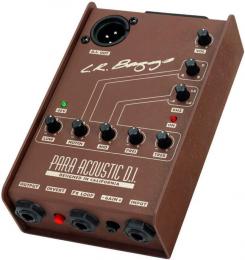
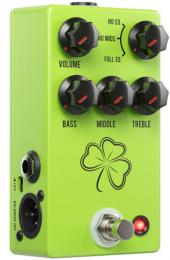
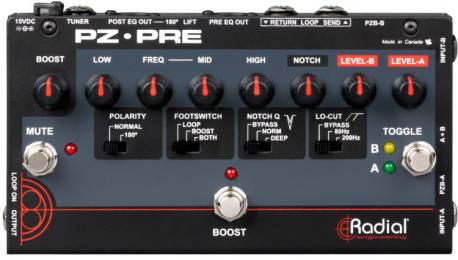


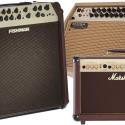

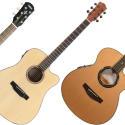
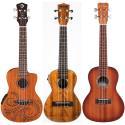

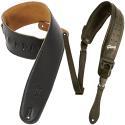
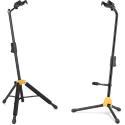
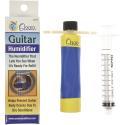
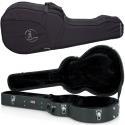
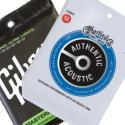
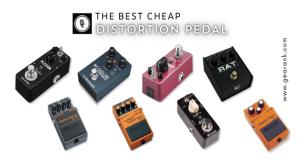

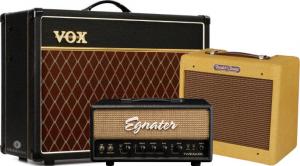
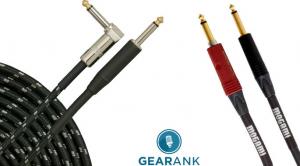
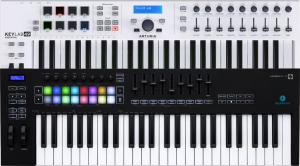
Comments
The following preamps came
Submitted by Jason Horton on
The following preamps came off our recommended list when we published the September 2022 Edition:
Publication of our April 2022
Submitted by Jason Horton on
Publication of our April 2022 Edition resulted in the following preamps coming off the recommended list above:
You totally missed the boat !
Submitted by Wizard (not verified) on
You totally missed the boat ! NOE of the preamps you reviewed are any good. The best of the best is the BBE Acoustamax and you didn't even review it. Dumb. I've used most of these and the LR Baggs is garbage.
We have analyzed the BBE
Submitted by Jason Horton on
We have analyzed the BBE Acoustimax and its ratings were not high enough for us to recommend it in this edition of the guide.
You can see its rating score and our analysis of it at: BBE Acoustimax Acoustic Preamp
Do you have any experience
Submitted by Anonymous (not verified) on
Do you have any experience with the cheap chinese pedals like the Joyo AD-2 or the Harley Benton? Thanks
Today we removed the
Submitted by Jason Horton on
Today we removed the following acoustic preamp from the recommended list above due to it having been discontinued but you can still read our analysis of it: Boss AD-8.
Are these preamps necessary
Submitted by Brad (not verified) on
Are these preamps necessary if I’ve got a processor like the Boss VE-8?
The Boss VE-8 has built-in
Submitted by Jason Horton on
The Boss VE-8 has built-in preamps for both acoustic guitar and condenser mics so you don't need an additional acoustic preamp.
As a result of our December
Submitted by Jason Horton on
As a result of our December 2018 update, the following acoustic preamps came off our recommended list above but you can still read our analysis of them:
How about Zoom A3?
Submitted by Jim (not verified) on
How about Zoom A3?
We examined it but we decided
Submitted by Jason Horton on
We examined it but we decided not to recommend it based on it's lower ratings - you can see the current Zoom A3 Ratings here.
Do you know of an alternative
Submitted by Ben (not verified) on
Do you know of an alternative to the K&K Trinity preamp? The K&K stereo (2 channel) preamp only takes a 9 volt battery (no AC or 48V option) and requires a DI box between the preamp and a PA (board/interface). So I'm looking for something that it accepts a TRS (stereo) signal and then allows for shaping of each channel independently. Plus if the alternative has an XLR (DI) out.
I did some of the work on
Submitted by Jason Horton on
I did some of the work on this guide and I don't recall seeing anything that resembled your requirements from any of the major manufacturers.
tonebone, input one is a
Submitted by Anonymous (not verified) on
tonebone, input one is stereo
dtar
aer dual mix
felix grace design
quantum k&k
orange acoustic preamp
headway
there is a lot out there of what your looking for
Grace Design AliX (or FeLIX),
Submitted by john (not verified) on
Grace Design AliX (or FeLIX), outstanding sound, just like their mic pres.
Fire-eye Develoment Redeye.
Submitted by D. Simmons (not verified) on
Fire-eye Develoment Redeye. Pros all over Nashville are using this. Solid company, rock star preamp. Super simple but clean with TONS of headroom. And, XLR phantom power and 9v to boot. Built like a tank. They have a 2 channel version also.
Thank you very much for
Submitted by Jason Horton on
Thank you very much for reminding us about Fire-Eye.
Originally they didn't meet our availability criteria because they're not sold through any of the specialty major music gear stores, however we've since relaxed our rules to include brands that only sell direct or via Amazon so I've added the Fire-Eye Red-Eye at the top of the list.
Headway EDB2 is long enough
Submitted by Bernd Lüdtke (not verified) on
Headway EDB2 has been long enough on the market to give it a mention.
I have added the Headway EDB
Submitted by Jason Horton on
I have added the Headway EDB-2 to our database.
Although it got mixed reviews from some customers, it has to be said that Bob Thomas gave it a very good review in Sound on Sound.
Do you know anything about
Submitted by Terry (not verified) on
Do you know anything about the boss AD5 ? Could it be used with a BBE acoustimax or does it have to be separate?
This week, I called Fishman
Submitted by Steve (not verified) on
This week, I called Fishman and asked specifically about the Fishman Aura vs. Fishman Platinum. I liked the tuner better on the Aura, but wondered about my onboard electronics on my Taylor 814. They said the all-analog Platinum Pro EQ would be just as effective and possibly better for me. I explained that I missed the old Fishman Prefix Blender system in my old 2000 Taylor 714. I got the impression that the Aura doesn't always mesh well with the Taylor pickups. Thoughts? I wish I could have compared them side by side...
What are your thoughts about
Submitted by Joseph R (not verified) on
What are your thoughts about the LR Baggs Session?
Here's meta-review of the LR
Submitted by Jason Horton on
Here's our information on the LR Baggs Session DI Acoustic Preamp.
The LR Baggs Session DI
Submitted by Alexander Briones on
The LR Baggs Session DI initially had a spot on this list with its Gearank score of 86, but it was replaced by the better ranked LR Baggs Para DI.
From the data we gathered, the Session DI's compact size and deep tone shaping controls were well loved by users. Although there were some that complained about the complexity and the price tag.
Still, it's an easy recommendation if you prefer the stompbox form factor, and want a good handle of your amplified sound.
How about including the Fire
Submitted by Paul Simmons (not verified) on
How about including the Fire eye Red-Eye?
I've read a lot of great
Submitted by Alexander Briones on
I've read a lot of great things about the the Fire Eye Red-Eye, unfortunately it did not meet our criteria for availability, where it should be available from major music gear retailers.
Why did you not include the
Submitted by John Moody (not verified) on
Why did you not include the LR Baggs para DI? It would have been a good review with the LR Baggs para DI in the test.
We have updated the list to
Submitted by Alexander Briones on
We have updated the list to include the LR Baggs Para DI, indeed it deserves a spot on this list.
The LR Baggs Para DI
Submitted by Jason Horton on
The LR Baggs Para DI currently has a Gearank score of 92 (I just updated it today) which means it will very likely be included when we do our next update of this Gear Guide which is scheduled for later this month.